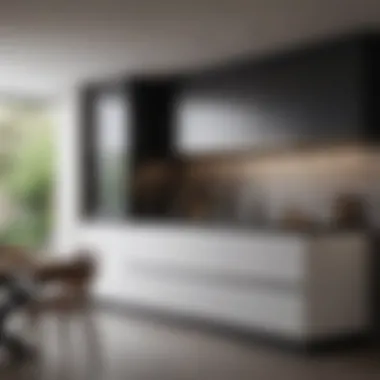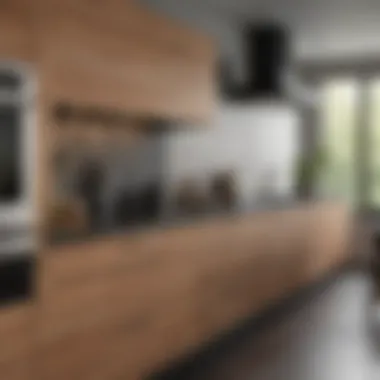The Ultimate Guide to Buying Kitchen Cabinets


Intro
Choosing the right kitchen cabinets is a significant decision for any homeowner. Cabinets play a crucial role in both aesthetic appeal and functionality within the kitchen. They not only provide storage but also set the tone for the overall design. Thus, understanding the best places to purchase these cabinets should be a priority for anyone considering a renovation or build.
Many factors come into play, including price, quality, selection, and customer service. The landscape of cabinet shopping has evolved, with numerous options available both online and in physical stores. Knowing where to look can ensure that you find cabinets that suit your style, budget, and needs. This article will delve into various retailers and considerations that can guide your decision-making process.
Ultimately, the goal is to empower you with the knowledge necessary to select kitchen cabinets that enhance not only the functionality of your kitchen but also its visual appeal.
Design Inspiration
The kitchen is often viewed as the heart of the home. Therefore, it is essential to create a space that feels inviting and reflects personal style. Below, we'll explore important design inspirations that can help homeowners make informed choices regarding their kitchen cabinets.
Trending Styles
Understanding the current trends in kitchen cabinetry can provide great insight into making a selection that is not only functional but also fashionable. Popular styles include:
- Shaker: Characterized by a simple, clean line, this style is versatile and can fit both traditional and modern kitchens.
- Flat-panel: This minimalist style works well in contemporary spaces. Its sleek appearance offers a modern touch.
- Traditional: Featuring ornate details, this style is ideal for classic kitchens aiming for a warm, inviting feel.
- Rustic: Incorporating natural materials, rustic cabinets bring a cozy, homey vibe to the kitchen.
Color Palettes
The selection of color can dramatically influence the mood and style of kitchen cabinetry. Some popular palettes include:
- White: A timeless choice that ensures brightness and a feeling of spaciousness.
- Gray: Offers a modern aesthetic while remaining warm and inviting.
- Navy Blue: A bolder choice that can make cabinetry stand out and add depth to the kitchen.
- Natural wood finishes: Emphasizes authenticity and can create a rustic or organic feel.
Choosing the right color is essential for aligning your cabinets with the overall kitchen design.
Practical Tips
After considering the design aspects, practicalities must also be taken into account when selecting kitchen cabinets. Below are a few tips that can enhance your shopping experience and ensure satisfaction.
Maintenance & Care
Not all materials require the same level of maintenance. Here are some considerations for common cabinet materials:
- Wood: While it offers a beautiful finish, wood is susceptible to scratches and humidity. Regular cleaning and occasional refinishing may be necessary.
- Laminate: This is generally easier to clean and does not require refinishing, but it can be prone to chipping.
- Metal: Resistant to stains and moisture, but can show fingerprints and scratches easily.
Understanding these maintenance requirements can help in deciding what materials fit best into your lifestyle.
Budgeting & Planning
Creating a budget is crucial before starting your cabinet shopping. Here's how to plan effectively:
- Establish a range: Determine how much you are willing to spend on cabinets. Keep in mind that high-quality cabinets may offer better longevity but can come at a higher initial cost.
- Consider installation: Factor in potential installation costs. Some retailers offer free installation but others may charge.
- Shop around: Visit multiple retailers to compare costs and options. Ensure to include both online and local stores in your search.
- Look for sales: Sales events can significantly cut costs. Keep an eye out for seasonal promotions.
With careful planning, you can manage expenses while achieving the kitchen look you desire.
"The kitchen is where we come together, share meals, and create memories. Choosing the right cabinets is essential for both functionality and style."
Understanding Kitchen Cabinets
Understanding kitchen cabinets is crucial for anyone who wants to enhance their kitchen. Cabinets serve not only practical functions but also contribute significantly to the aesthetic appeal of this central space in a home. The choices available can be overwhelming, but understanding the fundamentals simplifies the decision-making process. This section will guide readers through the basics of kitchen cabinets, focusing on their definitions, types, and the importance of quality.
Defining Kitchen Cabinets
Kitchen cabinets are essential storage solutions commonly found in kitchens. They are designed to hold kitchenware, food items, and appliances, making them vital for organization and accessibility. Cabinets usually consist of a box-like structure that can be mounted on walls or placed on the floor.
They often come with doors and may include features like drawers and shelves. Knowing what kitchen cabinets are clarifies their role in home design.


Types of Kitchen Cabinets
Kitchen cabinets come in various forms, each serving different purposes. Understanding these types is critical when deciding where to purchase them.
Base Cabinets
Base cabinets are the foundational units in a kitchen. They sit directly on the floor and support countertops while providing essential storage space. Their height typically aligns with standard counter levels, making them convenient for daily kitchen tasks. Their main characteristic is their sturdy structure, ideal for supporting heavy kitchen appliances. Base cabinets often include drawers for easy access to utensils and cooking tools. A unique aspect of base cabinets is their versatility; they can have various finishes and designs. However, their size limits their placement to lower areas, which might not suit all design preferences.
WALL Cabinets
Wall cabinets are mounted above the countertops. They provide additional storage without consuming valuable floor space. Their key characteristic is their variety in height and width, which enables customization based on the kitchen layout. Wall cabinets are beneficial because they keep frequently used items within reach while freeing up counter space. However, they can be challenging to access for shorter individuals, so it's critical to design the layout thoughtfully.
Specialty Cabinets
Specialty cabinets cater to specific needs and functionality. These can include wine racks, pull-out pantries, and corner cabinets designed for awkward spaces. Their key characteristic is their unique designs tailored for storage solutions that regular cabinets may not offer. Specialty cabinets add distinctive storage options, elevating the overall kitchen design. One disadvantage might be their potentially higher costs compared to standard options, which can affect the overall budget.
Importance of Quality in Kitchen Cabinets
The quality of kitchen cabinets plays a fundamental role in their longevity and functionality. High-quality cabinets are typically made from durable materials that can withstand the wear and tear of daily use. Poor quality may lead to frequent repairs or replacements, which can be costly and inconvenient. Additionally, well-made cabinets often enhance the overall appearance of the kitchen and can add value to a home. Therefore, evaluating quality is as essential as understanding types to ensure making a wise investment.
Retail Options for Kitchen Cabinets
Local Home Improvement Stores
Local home improvement stores are often the first stop for many consumers looking to buy kitchen cabinets. These stores typically offer a wide selection of cabinets, from stock options to semi-custom designs. The benefits of shopping at a local store include the ability to physically inspect the products. Homeowners can see the construction quality, finish, and color first-hand, which is invaluable for making a choice.
Additionally, local stores usually offer knowledgeable staff who can provide guidance on installation and product features. This direct interaction can be beneficial, especially for those who are new to DIY home improvement projects. However, it's worth noting that prices at local home improvement stores can sometimes be higher than those found online or in larger chains due to their overhead costs.
Specialty Cabinet Retailers
Specialty cabinet retailers provide a more focused approach to kitchen cabinetry. These stores often offer custom or high-end cabinetry, allowing for unique designs that cater to the specific preferences of the homeowner. One of the main advantages of purchasing from specialty retailers is the expertise available. Staff members are usually trained specifically in cabinetry and can help with design choices, materials, and styles that best fit a client’s kitchen layout and lifestyle.
Moreover, specialty cabinet retailers often provide a range of accessories and enhancements that can complement the cabinetry, such as hardware and soft-close mechanisms. While prices may vary widely depending on customization, these retailers can help create a kitchen that is both functional and aesthetically pleasing.
Big Box Retailers
Big box retailers, like Home Depot and Lowe’s, serve as a hybrid between local stores and specialty retailers. They generally offer a vast selection of kitchen cabinets at competitive prices, making them accessible for a broader audience. The advantage of buying cabinets from big box retailers is their combination of affordability and variety. Shoppers can find both stock and semi-custom options, along with numerous materials and finishes.
Additionally, these retailers often provide online shopping, allowing for easy browsing from home. Some have online calculators for estimating costs based on the selected cabinets, making it easier to stay within budget. However, the downside may include less personalized service, as staff might not have the same level of expertise as those in specialty stores. Understanding which retailer aligns best with your needs can help ensure a satisfactory cabinet buying experience.
"Selecting the right retailer is not just about price; it's about the quality of assistance and products that shape the overall value of your kitchen cabinetry."
When evaluating where to buy kitchen cabinets, homeowners should consider what matters most to them: price, selection, expertise, or convenience. Each retail option carries its own set of benefits that cater to different buyer preferences.
Online Retailers for Kitchen Cabinets
The rise of the internet has transformed how homeowners shop for furniture, especially kitchen cabinets. Online retailers provide vast selections and conveniences that traditional stores may lack. By leveraging digital platforms, consumers can access comprehensive product information and customer reviews that enhance decision-making processes.
Online shopping allows for easy comparisons among brands. Consumers can analyze prices, styles, and even shipping options at a glance. This immediacy can be advantageous for those who have busy schedules.
Benefits of Online Shopping
Several factors make online shopping for kitchen cabinets a compelling choice.
- Convenience – You can shop from home at any time, eliminating the need for lengthy store visits.
- Wider Selection – Online retailers often feature a broader array of styles, colors, and materials than local stores.
- Price Comparison – It is easy to compare prices across different sites before making a purchase.
- Customer Reviews – Access to feedback from other buyers can help inform choices about quality and durability.
Comparative Analysis of Major Online Retailers
Wayfair


Wayfair is notable for its extensive inventory and user-friendly platform. They specialize in home goods, including kitchen cabinets, and offer a plethora of options. A key characteristic of Wayfair is their frequent sales and promotions. Consumers often find competitive pricing here. Additionally, Wayfair offers a user-friendly return policy, making it a more secure choice for first-time buyers. Their customer service is praised for responsiveness, although, at times, shipping speed could vary.
Cabinets.com
Cabinets.com excels in providing a focused selection specifically for cabinetry. This website allows users to design their layouts, enhancing the customization experience. The unique feature of Cabinets.com is their free design assistance. Potential buyers benefit from expert guidance to fulfill specific requirements. However, their inventory can be limited in comparison to larger retailers. Customers may need to sacrifice variety for specialized offerings.
Home Depot Online
Home Depot Online integrates the physical store's strengths with an online platform. It combines a vast selection of kitchen cabinets from various brands along with detailed product specifications. Home Depot is also known for its excellent customer support and options for installation services. One notable advantage is their buy online, pick up in-store option. This provides a seamless transition from online shopping to real-world access. However, their online experience can sometimes be less intuitive than dedicated online retailers.
Custom Cabinetry Options Online
Many online retailers also provide custom cabinetry solutions, allowing buyers to tailor their cabinets according to precise specifications. This option may include personalization of dimensions, finishes, and hardware choices. Custom cabinetry is particularly beneficial for unique spaces or specific design preferences that standard sizes cannot accommodate. Typically, purchasing custom cabinets online involves direct interaction with manufacturers, potentially leading to longer lead times. Thus, assessing the supplier's reliability is crucial.
Factors to Consider When Buying Kitchen Cabinets
When venturing into the world of kitchen cabinets, several essential factors come into play. Each detail can affect the final outcome of your kitchen, from aesthetics to functionality. These considerations not only shape your kitchen's look but also the overall experience of using the space.
Budget Constraints
Understanding your budget is crucial when buying kitchen cabinets. It is often the first thing that people think about. Cabinets can vary significantly in price, influenced by their style, material, and brand. When you set a budget, think about both the cost of the cabinets and any additional expenses associated with delivery and installation.
Additionally, consider the possibility of getting quality cabinets at a lower price. Look for sales or online discounts. Investing a bit more into quality can offer better durability and functionality, ultimately saving you money in the long run. Think also about how much you plan to spend on other kitchen renovations, as this might affect your spending limit on cabinets.
Space and Layout Considerations
Each kitchen has a unique layout. Before deciding on cabinet types and sizes, assess your available space. Note where appliances, sinks, and fixtures are located. This can determine the size of your cabinets. For instance, corner cabinets may be a good choice for space efficiency.
Consider vertical space as well. High ceilings allow for tall cabinets, which can maximize storage. If your kitchen area is limited, slim cabinets could maintain an open feel while providing functionality.
Design and Style Preferences
Your kitchen should reflect your style and preferences. Consider the overall appearance you want to achieve. Modern kitchens may benefit from sleek, minimalist designs, while traditional homes might favor more ornate cabinet styles. Certain finishes, colors, and hardware can dramatically alter the ambiance.
Research different styles and visualize how these cabinets would fit into your existing kitchen components. Remember, consistency in design creates a cohesive environment, so choose cabinets that harmonize with your floors, countertops, and walls.
Material and Finish Selection
Cabinet materials significantly impact durability and maintenance. Solid wood is a popular choice due to its strength and aesthetic appeal, but it can be more expensive. Options like plywood or particleboard are more affordable but may not offer the same longevity. Keep in mind the finish as well. Some finishes are susceptible to scratches or stains, while others offer better resilience.
It’s also essential to consider the color and texture of the finish. Lighter tones can open spaces, while darker shades provide a rich, warm feel. If you have children or pets, opting for a finish that withstands stains may be wise.
"The right combination of material and finish can enhance both the beauty and functionality of your kitchen cabinets."
Delivery and Installation Options
Understanding the Delivery and Installation Options is pivotal for anyone considering the purchase of kitchen cabinets. It goes beyond merely selecting a style or color; how cabinets reach your home and how they are installed can significantly affect your overall experience and satisfaction. Key concerns such as scheduling, costs, and labor impact the success of your renovation. Knowing what to expect in delivery timelines and installation processes is crucial for planning.
Understanding Delivery Services
When purchasing kitchen cabinets, delivery services are fundamental to the process. This involves more than just dropping off boxes at your doorstep. Here are several points to consider:
- Timing: Understand the delivery timelines. Depending on the retailer, you might wait several days to weeks for your cabinets to arrive. This might delay your renovation plans.
- Condition of products: Inspect cabinets upon delivery. Take note of any damages or imperfections that may have occurred during transit.
- Delivery Fees: Some retailers include delivery in the price, while others add it later. Be cautious and read terms to avoid surprises.
- Assembly Support: Certain retailers offer delivery with assembly assistance, ensuring your cabinets are ready for installation. This can be a valuable option for those without experience.
"Informed decision-making regarding delivery options can save time and prevent potential headaches in your renovation journey."
DIY Installation vs Professional Help
The choice between DIY installation and hiring professionals is significant and can impact both the cost and the quality of the finished product. Here are some considerations:


DIY Installation
Opting for DIY can save money. However, it requires a level of skill and commitment:
- Cost-Effective: No labor fees are involved, thereby reducing your overall budget.
- Personal Satisfaction: Successfully completing a project can be rewarding.
- Time-Consuming: Without experience, installation may take much longer than expected.
- Mistakes: Potential for errors can lead to additional repair costs.
Professional Help
Hiring a professional might incur higher costs but can offer advantages:
- Experience: Professionals often have the knowledge to install cabinets efficiently and correctly.
- Guarantee of quality: Many contractors guarantee their work, offering peace of mind.
- Time-Saving: Professionals can usually complete the job more quickly than a DIY approach.
Ultimately, the decision hinges on your comfort level with home improvement projects, budget, and timeline. Each option has its own set of benefits and drawbacks, and understanding these can guide your choice. Knowing how delivery and installation will unfold can lead to a much smoother renovation process. It is vital to keep these factors in mind as you make your kitchen cabinet selection.
Customer Reviews and Recommendations
Customer reviews and recommendations play a crucial role in the decision-making process for purchasing kitchen cabinets. They provide insight into the experiences of those who have already navigated the complexities of buying cabinets. When considering a significant investment such as cabinetry, it is essential to look beyond marketing claims and evaluate actual user experiences.
Reviews can offer valuable information about the quality, durability, and functionality of various cabinet brands. They often highlight specific features that either enhance or detract from the overall satisfaction of a purchase. Moreover, consumer feedback can reveal trends in customer service experiences, delivery times, and warranties provided by retailers. Positive reviews can build trust while negative reviews may serve as warnings about potential pitfalls.
One of the greatest benefits of consulting customer reviews lies in their ability to inform potential buyers about real-life performance. Many home improvement decisions hinge on aesthetics, but functionality, maintenance, and longevity are equally significant. This feedback can lead to smarter choices that ensure long-term satisfaction.
Evaluating Customer Feedback
When evaluating customer feedback, it’s vital to consider a few key elements to distinguish helpful reviews from less meaningful ones. Look for reviews that provide detailed accounts rather than vague comments. Here are some factors to consider:
- Specificity: Reviews that discuss particular features or issues offer deeper insights. For instance, if multiple reviews mention a cabinet's ease of installation or scratches easily, that is useful information.
- Volume: A higher number of reviews can indicate trustworthiness. If a specific cabinet model has several reviews, it may present a clearer picture of its performance.
- Recency: Check the dates of the reviews as more recent feedback will likely reflect the current quality and service levels of a product or retailer.
- Source: Trusted review platforms, such as Reddit or larger home improvement sites, can provide a more comprehensive view compared to social media comments.
"Customer feedback offers a unique view into product performance that marketing materials alone cannot provide."
Expert Recommendations
Expert recommendations can complement customer reviews by offering professional insights based on experience and industry standards. These endorsements often come from individuals who have extensive knowledge about cabinetry and home design. Experts can assist homeowners in making more informed decisions. Some considerations include:
- Industry Standards: Experts often reference recognized standards for quality and sustainability. This information can guide buyers towards reliable products.
- Trends: Understanding current trends in cabinetry can help homeowners select designs and finishes that remain stylish over time.
- Product Comparisons: Experts can provide side-by-side comparisons of different brands, highlighting strengths and weaknesses based on firsthand experience.
Combining customer reviews with expert recommendations can lead to a holistic understanding of what to expect from a cabinet purchase. This process empowers buyers to make selections that align with their own goals for quality, budget, and overall design aesthetic.
Final Considerations
In the search for the optimal place to purchase kitchen cabinets, there are several final considerations that must be addressed. The process is not merely transactional; it is a blend of long-term benefits, sustainability, and eco-conscious decisions that resonate with modern homeowners. Understanding these aspects can enhance not only the buyer's immediate satisfaction but also the enduring value of their investment in kitchen cabinetry.
When it comes to choosing cabinets, it’s crucial to look beyond price tags. The durability and functionality of cabinets often outweigh initial costs and contribute to their overall worth. Homeowners should weigh if they want cabinets that can withstand years of use without needing replacement.
Several elements should guide your decision-making process. Consider what matters most to you in your kitchen remodeling project. This might include aesthetics, space planning, or specific features. Additionally, consider the quality of materials used, the brand reputation, and after-sales service, if applicable.
Finally, your choice of cabinets is not just a reflection of personal style but also an investment in your home's value. Quality cabinets can enhance the overall appeal of the kitchen and consequently the marketability of the home itself. Therefore, it becomes essential to analyze the long-term implications before settling on a purchase decision.
Long-term Investment Considerations
Investing in kitchen cabinets is often a significant financial commitment. It is the cornerstone of a kitchen design and can determine the overall aesthetic as well as functionality. High-quality cabinets could potentially offer a return on investment that lower-cost alternatives do not fulfill.
When considering this investment, take into account:
- Durability: Materials such as plywood and solid wood tend to stand the test of time better than particle board.
- Warranty and Support: A long warranty often indicates confidence in the product's longevity.
- Resale Value: Well-built cabinets can make your home more attractive to potential buyers in the future.
In choosing kitchen cabinets, look for options that not only fit your design but also offer sturdy construction and reputable support. Your choice today can have lasting effects on your home's comfort and value tomorrow.
Sustainability and Eco-Friendliness
Sustainability and eco-friendliness have risen in importance for many consumers today. Choosing kitchen cabinets that align with these principles is a way to not only enhance your home but also reduce your environmental footprint.
Opting for cabinets made from sustainable materials, such as bamboo or certified wood products, can make a significant impact. Some brands focus on environmentally friendly practices in their manufacturing processes, thus contributing less to pollution and waste.
Factors to consider in this area include:
- Material: Look for certifications like FSC (Forest Stewardship Council) to ensure responsible sourcing.
- Finishes: Water-based finishes are often less harmful than solvent-based ones and contribute to better indoor air quality.
- Longevity: Choosing durable cabinets means less frequent replacements and less waste.
Implementing these eco-friendly choices in kitchen cabinetry not only boosts your space but also reflects a conscientious effort towards sustainability and responsible living.















